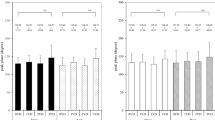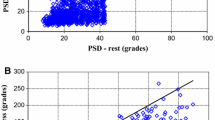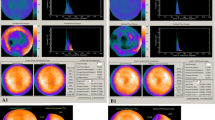Abstract
Objective
A count-based new technique from gated myocardial perfusion single-photon emission tomography (gMPS) was developed to allow the phase analysis providing information about the left ventricular (LV) regional discordance in contractility which is a measure of LV dyssynchrony. Since the phase analysis provides data for evaluating the dyssynchronous LV contraction, it has an important role in diagnosis and management of patients with left ventricular dysfunction. The aim of the study was to assess the presence of left ventricular dyssynchrony in patients with reversible perfusion defects on gMPS scans and normal or near normal coronary arteries at angiography.
Methods
32 patients (19 men, 59 %) with reversible mild perfusion defects on gMPS and normal coronary angiogram were retrospectively enrolled in the study. The peak of the phase histogram, the standard deviation of the phase distribution (PSD), the width of the band (PHB), and the symmetry and peakedness of the phase histogram, which are the assessment parameters for the LV dyssynchrony, were calculated from gMPS scans of patients by means of the phase analysis.
Results
Although, five quantitative variables are derived from the phase analysis of gMPS, PSD and PHB are two quantitative indices to assess LV global mechanical dyssynchrony and measurements of PSD (men 24.96 ± 7.31, women 24.26 ± 10.07) and PHB (men 70.1 ± 13.99, women 71.0 ± 30.4) were significantly higher than the those reported in the literature (p < 0.001). No significant differences in gMPS phase analysis indices were found between both sexes except kurtosis.
Conclusion
As a conclusion, this study provides the phase analysis to detect LV mechanical dyssynchrony as new evidence supporting the concept that an abnormal scintigraphy finding, rather than being false-positive, may be an early marker of vasomotion changes associated with occult atherosclerosis in patients with normal coronary angiography findings.
Similar content being viewed by others
References
Notghi A, Low CS. Myocardial perfusion scintigraphy: past, present and future. Br J Radiol. 2011;84:229–36.
Flotats A, Knuuti J, Gutberlet M, Marcassa C, Bengel FM, Kaufmann PA, et al. Cardiovascular Committee of the EANM, the ESCR and the ECNC. Hybrid cardiac imaging: SPECT/CT and PET/CT. A joint position statement by the European Association of Nuclear Medicine (EANM), the European Society of Cardiac Radiology (ESCR) and the European Council of Nuclear Cardiology (ECNC). Eur J Nucl Med Mol Imaging. 2011;38:201–12.
Chen J, Garcia EV, Folks RD, Cooke CD, Faber TL, Tauxe EL, et al. Onset of left ventricular mechanical contraction as determined by phase analysis of ECG-gated myocardial perfusion SPECT imaging: development of a diagnostic tool for assessment of cardiac mechanical dyssynchrony. J Nucl Cardiol. 2005;12:687–95.
Chen J, Garcia EV, Bax JJ, Iskandrian AE, Borges-Neto S, Soman P. SPECT myocardial perfusion imaging for the assessment of left ventricular mechanical dyssynchrony. J Nucl Cardiol. 2011;18:685–94.
Matsuo S. Phase analysis using gated myocardial perfusion single-photon emission computed tomography imaging for evaluating cardiac dyssynchrony. Circ J. 2012;76:1832–3.
Uebleis C, Hellweger S, Laubender RP, Becker A, Sohn HY, Lehner S, et al. Left ventricular dyssynchrony assessed by gated SPECT phase analysis is an independent predictor of death in patients with advanced coronary artery disease and reduced left ventricular function not undergoing cardiac resynchronization therapy. Eur J Nucl Med Mol Imaging. 2012;39:1561–9.
Doukky R. Pharmacologic stress testing in myocardial perfusion imaging: Technical application. In: Heller GV, Mann A, Hendel RC, editors. Nuclear cardiology: practical applications. New York: The McGraw-Hill Companies; 2009. p. 107–18.
Garcia EV, Faber TL, Cooke CD, Folks RD, Chen J, Santana C. The increasing role of quantification in clinical nuclear cardiology. J Nucl Cardiol. 2007;14:420–32.
Chen J, Garcia EV, Lerakis S, Henneman MM, Bax JJ, Trimble MA, et al. Left ventricular mechanical dyssynchrony as assessed by phase analysis of ECG-gated SPECT myocardial perfusion imaging. Echocardiography. 2008;25:1186–94.
Geltman EM, Henes CG, Senneff MJ, Sobel BE. Increased myocardial perfusion at rest and diminished perfusion reserve in patients with angina and angiographically normal coronary arteries. J Am Coll Cardiol. 1990;16:586–95.
Verna E, Ceriani L, Giovanella L, Binaghi G, Garancini S. “False-positive” myocardial perfusion scintigraphy findings in patients with angiographically normal coronary arteries: insights from intravascular sonography studies. J Nucl Med. 2000;41:1935–40.
Delcour KS, Khaja A, Chockalingam A, Kuppuswamy S, Dresser T. Outcomes in patients with abnormal myocardial perfusion imaging and normal coronary angiogram. Angiology. 2009;60:318–21.
Cannon RO, Eptein SE. “Microvascular angina” as a cause of chest pain with angiographically normal coronary arteries. Am J Cardiol. 1988;61:1338–43.
Zehier AM, Drexler H, Wollschhlager H, Just H. Modulation of coronary vasomotor tone in humans: progressive endothelial dysfunction with different early stages of coronary atherosclerosis. Circulation. 1991;83:391–401.
Hasdai D, Gibbson RJ, Holmes DR, Higano ST, Lerman A. Coronary endothelial dysfunction in humans is associated with myocardial perfusion defects. Circulation. 1997;96:3390–5.
Erbel R, Ge J, Bockisch A, Kearney P, Görge G, Haude M, et al. Value of intracoronary ultrasound and Doppler in the differentiation of angiographically normal coronary arteries: a prospective study in patients with angina pectoris. Eur Heart J. 1996;17:880–9.
Lanza GA. Cardiac syndrome X: a critical overview and future perspectives. Heart. 2007;93:159–66.
Maseri A, Crea F, Kaski JC, Crake T. Mechanisms of angina pectoris in syndrome X. J Am Coll Cardiol. 1991;17:499–506.
Crea F, Lanza GA. Angina pectoris and normal coronary arteries. Heart. 2004;90:457–63.
Chen CC, Shen TY, Chang MC, Hung GU, Chen WC, Kao CH, et al. Stress-induced myocardial ischemia is associated with early post-stress left ventricular mechanical dyssynchrony as assessed by phase analysis of (201)Tl gated SPECT myocardial perfusion imaging. Eur J Nucl Med Mol Imaging. 2012;39:1904–9.
Aljaroudi W, Koneru J, Heo J, Iskandrian AE. Impact of ischemia on left ventricular dyssynchrony by phase analysis of gated single photon emission computed tomography myocardial perfusion imaging. J Nucl Cardiol. 2011;18:36–42.
Paul AK, Hasegawa S, Yoshioka J, Mu X, Maruyama K, Kusuoka H, et al. Characteristics of regional myocardial stunning after exercise in gated myocardial SPECT. J Nucl Cardiol. 2002;9:388–94.
Aljaroudi W, Alraies MC, DiFilippo F, Brunken RC, Cerqueira MD, Jaber WA. Effect of stress testing on left ventricular mechanical synchrony by phase analysis of gated positron emission tomography in patients with normal myocardial perfusion. Eur J Nucl Med Mol Imaging. 2012;39:665–72.
Trimble MA, Velazquez EJ, Adams GL, Honeycutt EF, Pagnanelli RA, Barnhart HX, et al. Repeatability and reproducibility of phase analysis of gated single-photon emission computed tomography myocardial perfusion imaging used to quantify cardiac dyssynchrony. Nucl Med Commun. 2008;29:374–81.
Author information
Authors and Affiliations
Corresponding author
Rights and permissions
About this article
Cite this article
Karacalioglu, A.O., Balta, Ş., Emer, O. et al. Phase analysis in patients with reversible perfusion defects and normal coronary arteries at angiography. Ann Nucl Med 27, 416–422 (2013). https://doi.org/10.1007/s12149-013-0700-1
Received:
Accepted:
Published:
Issue Date:
DOI: https://doi.org/10.1007/s12149-013-0700-1




